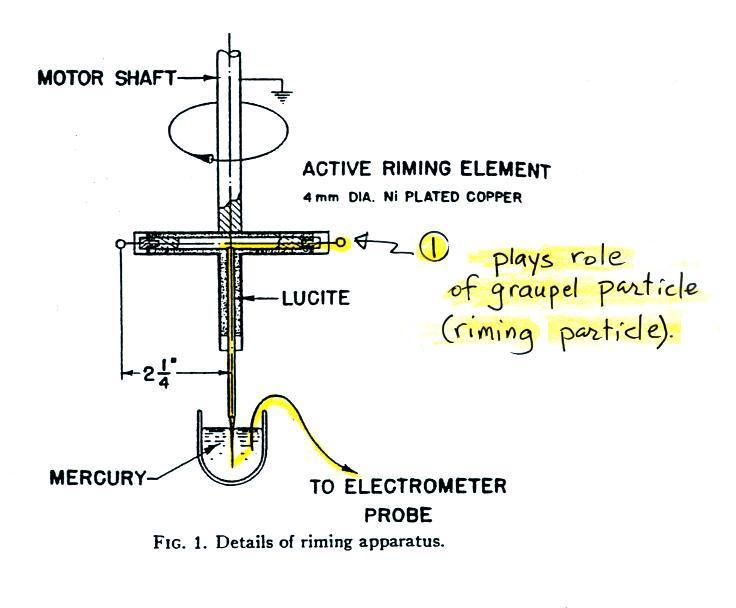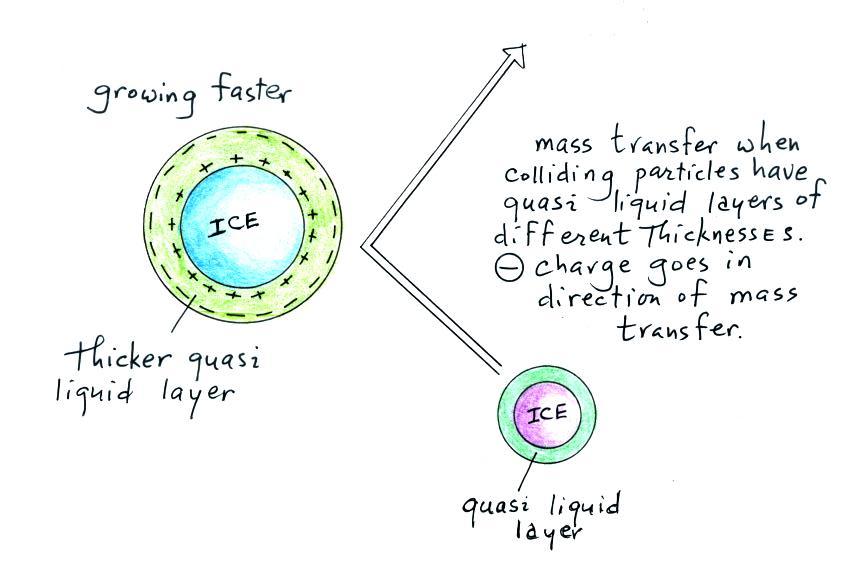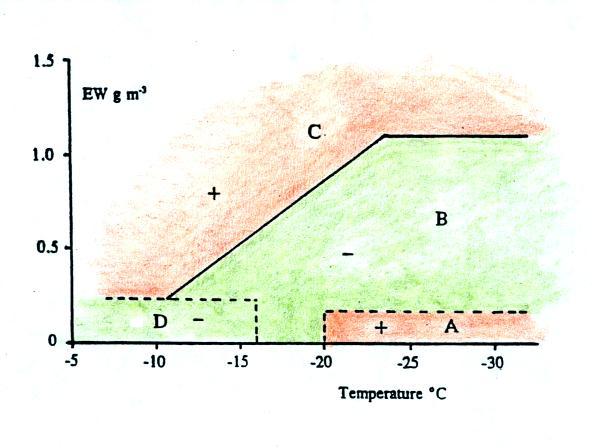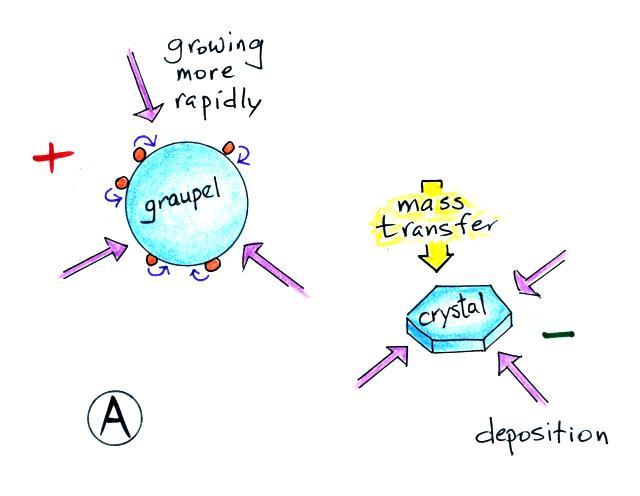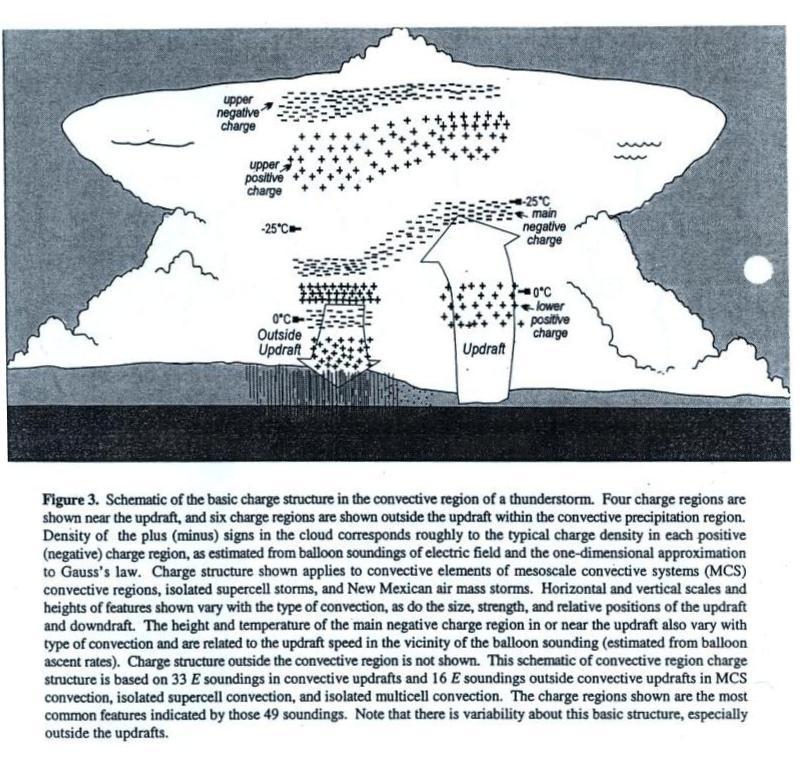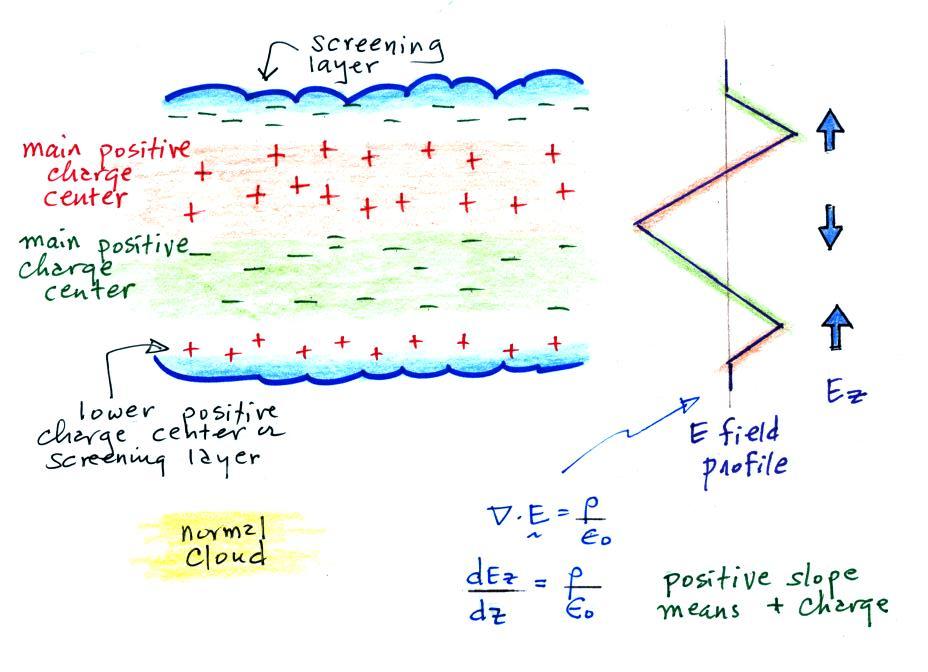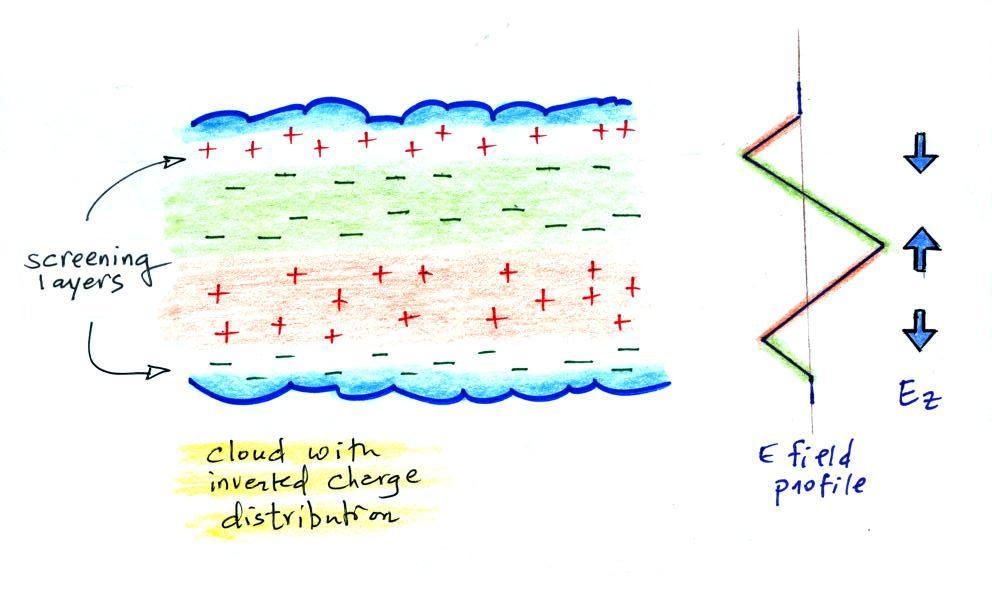This lecture will be devoted to qualitative descriptions of cloud
electrification processes. After short descriptions of the
convective process and an inductive process we'll spend the majority of
our time on the Reynolds, Brook, Gourley (non inductive) mechanism.
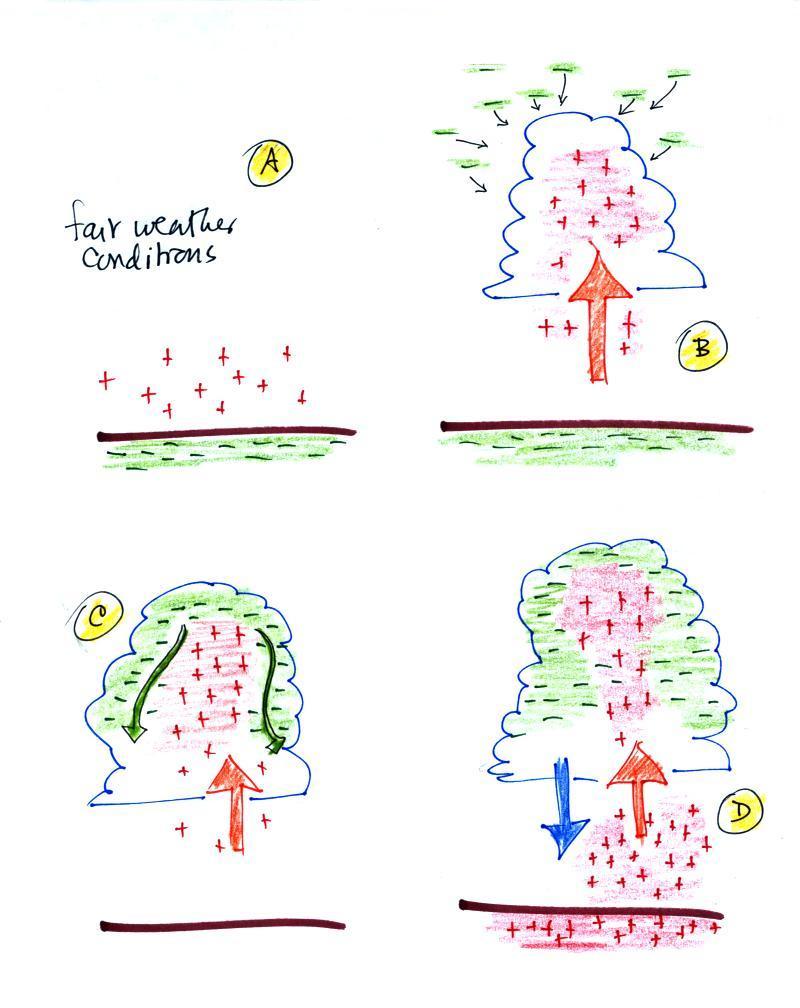
The convective theory starts with
the positive charge found in the air above the ground during fair
weather (Fig. A). In Fig. B an updraft and a cloud have started
to form and positive charge is carried upward into the cloud where the
charge attaches to cloud
particles. Negative charge carriers in the surrounding
air are
drawn to the positive charge in the top of the cloud and form a
screening layer. Cloud edge motions shown in Fig. C then begin to
carry this
negative charge
down and into the middle center of the cloud to form the main negative
charge center. The electric field at the ground intensifies
because of the close proximity of negative charge in the cloud.
Objects on the ground go into corona discharge and "spray" positive
charge into the air (Fig. D). This is one way of accelerating the
charging process.
While cloud motions can clearly have an effect on the distribution of
charge inside a thunderstorm, the convective theory is generally
not
considered to be a viable mechanism for the initial electrification of
thunderstorms.
In the inductive process an existing
(initially fair weather) field induces charges in precipitation
particles (in the same way charges were induced on a conducting sphere
in a uniform field).
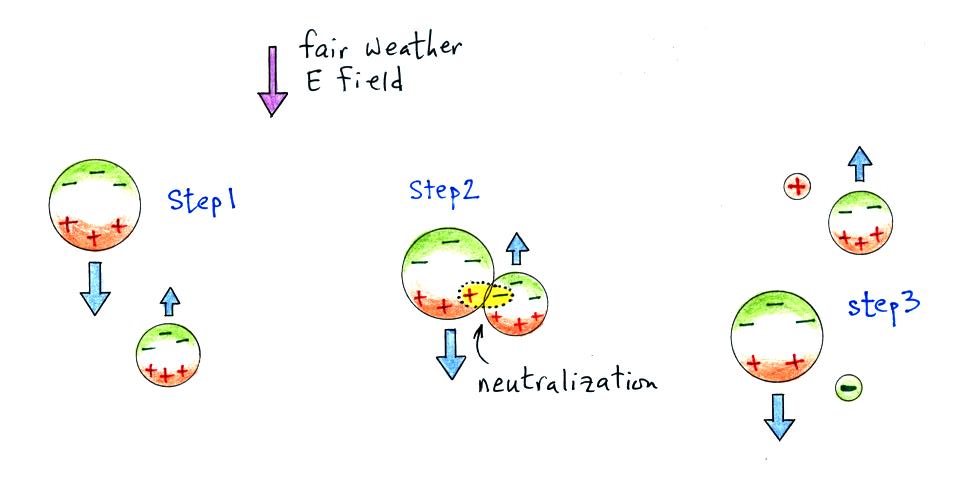
The downward pointing fair weather E
field induces equal amounts of negative and positive charge on the tops
and bottoms of different sized precipitation particles. Because
the particles are moving in different directions or at different
speeds, they collide. During the collision some of the
charge on each particle is neutralized. Each particle is left
with net charge following the collision.
water
-
water
|
ice -
ice
|
water -
ice
|
ice -
riming ice
|
Ice particle - ice particle collisions don't neutralize much charge
because the particles don't remain in contact for very long and charge
doesn't flow as readily through ice as it does through water.
Water - ice particle and ice - riming particle collisions might work,
but the general feeling still is that the inductive process is not able
to
start with a fair weather E field and turn it into a thunderstorm
strength field.
The
non-inductive process, also called the Reynolds, Brook, Gourley process
is generally thought to be the most viable explanation for the rapid
initial
electrification of thunderstorms. It doesn't require a existing
field. The process is shown in general
terms below. We will look at some of the details in a
little more
detail later.
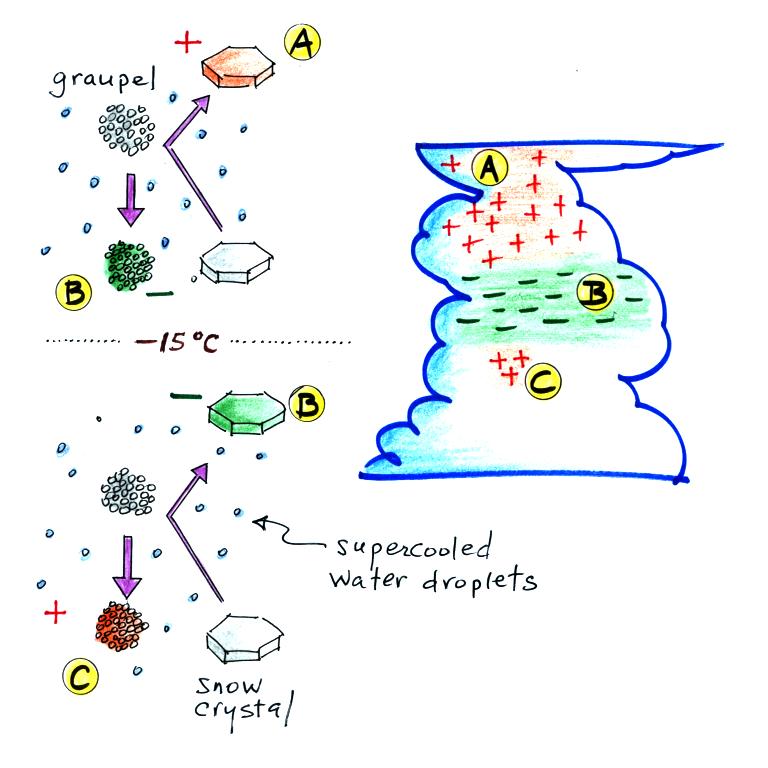
Basically graupel collides with a
snow crystal, in the presence of supercooled water droplets, and then
depending
on the environmental temperature, the graupel ends up with negative or
positive
charge and the ice crystal ends up with the opposite polarity.
At temperatures colder than about -15 C the snow crystal ends up with
positive charge and the graupel is negative. The different sizes
and fall velocities of the two types of particles
means they will tend to separate after the collision. The
negatively charged graupel tends to accumulate in the middle of the
cloud and the snow crystal is carried up to higher parts of the
cloud. At temperatures warmer than about -15 C the polarities
reverse. We will see that this charge reversal temperature can
vary depending on the cloud liquid water content. The letters
A, B, and C show how this process can account for the three main charge
centers in a thunderstorm (A & C are the upper and lower positive
charge centers, respectively; B is the main negative charge center)
The following figure shows the experimental apparatus used to make
the
initial measurements of charging.
[source: S.E. Reynolds, M. Brook, and Mary Foulks Gourley,
"Thunderstorm Charge Separation", J. Meteorology, 14, 426-436,
1957)
Two metal balls at the ends of arms mounted on a rotating shaft
simulate graupel particles in a cloud (pt. 1). These balls become
electrically charged the electrical path from the
balls to a sensitive electrometer has been highlighted in yellow.
A little bit wider view of the apparatus is shown below.
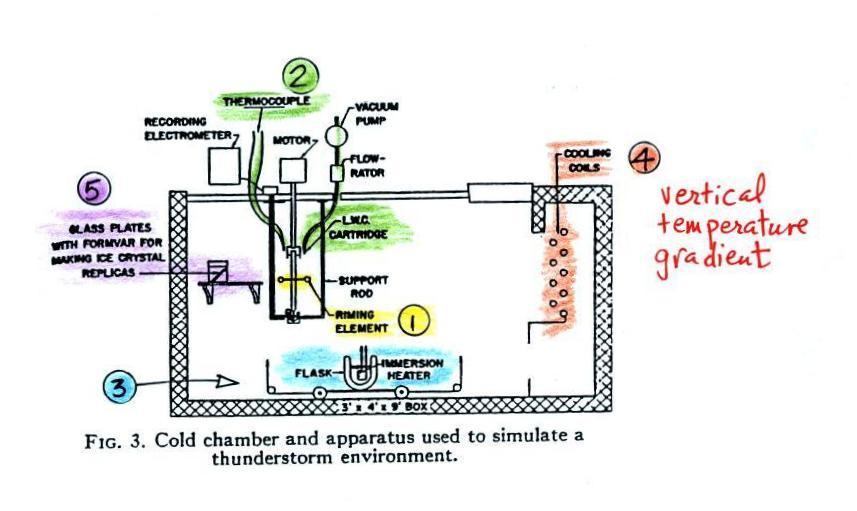
Temperature and liquid water content (LWC) are measured near the
spinning arms (pt. 2). Liquid water content is really just a
measure of the concentration of supercooled water droplets.
Warm water at pt. 3 is the source of water vapor. Cooling coils
(pt. 4) cool the air inside the chamber. Cold air will sink and
probably establish a vertical temperature gradient. The spinning
metal ball could be raised or lower to change the temperature of the
surrounding air. Replicas of
ice crystals that form can be collected at pt. 5 for later examination.
This would not be an easy experiment to conduct. It would be
difficult to create, measure, and monitor the cloud environment in the
chamber and the charging that does occur is probably very weak and a
sensitive electrometer would be needed.
The following information was copied from
the www.snowcrystals.com website (it is no longer accesible). It
briefly discusses the quasi-liquid layer that is found at the boundary
between ice and air.
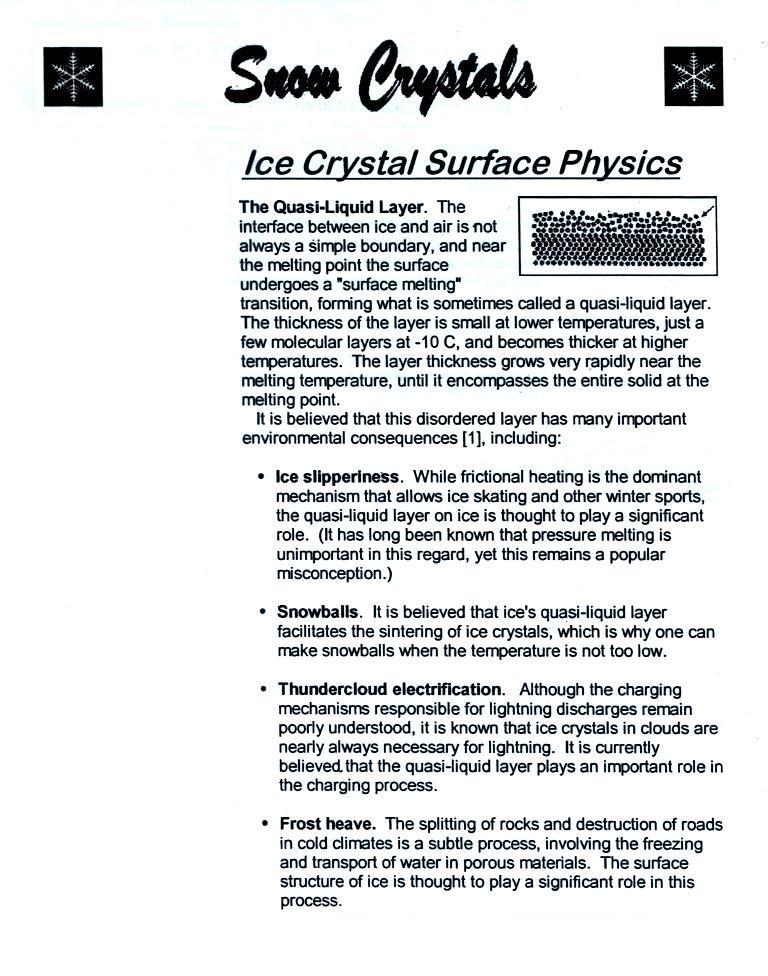
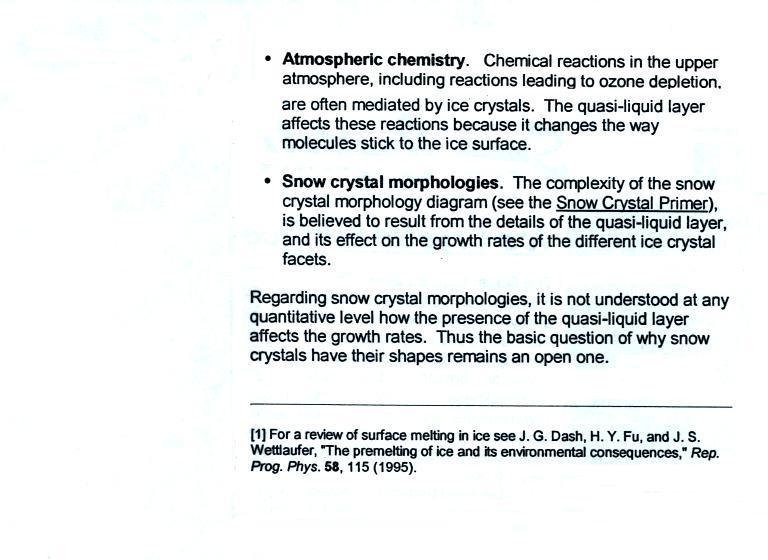
The quasi liquid layer seems to play an important role in charging
in the non inductive process.
The + and - polarities in the figure
refer to the charge on the
metal target that simulates a graupel particle in these laboratory
experiments. The charge depends on the
environmental temperature and on the cloud liquid water content as
shown in the figure above. EW on the vertical axis is
effective liquid water content and is
the product of liquid water content and collision efficiency (what
fraction of the supercooled water droplets colliding with the target
stick and eventually freeze to the target).
Here is my interpretation of what happens in regions A and B. The
temperature
is
low
in
both
cases.
The
difference is the
liquid water content, the concentration of supercooled water
droplets.
Region A
Supercooled droplets are
colliding with and sticking to the graupel particle at a relatively low
rate. That is because of the low effective liquid water
content. The droplets warm as
they release latent heat and try to freeze. The droplets warm but
there isn't enough latent heat energy release to warm the graupel
particle itself. So both the graupel and the ice crystal are cold
and the rates of deposition of water vapor to the graupel and the ice
crystal are about equal (deposition is the water vapor to
ice phase change). The graupel
gets some additional deposition from the warm water droplets on its
surface (the thin purple arrows from the droplets to the graupel
particle in the figure). As a result the graupel is growing more
quickly and has
the thicker quasi liquid layer. Mass transfer during a collision
with an ice crystal is to the ice crystal. The ice crystal ends
up with negative
charge, the graupel particle with positive charge.
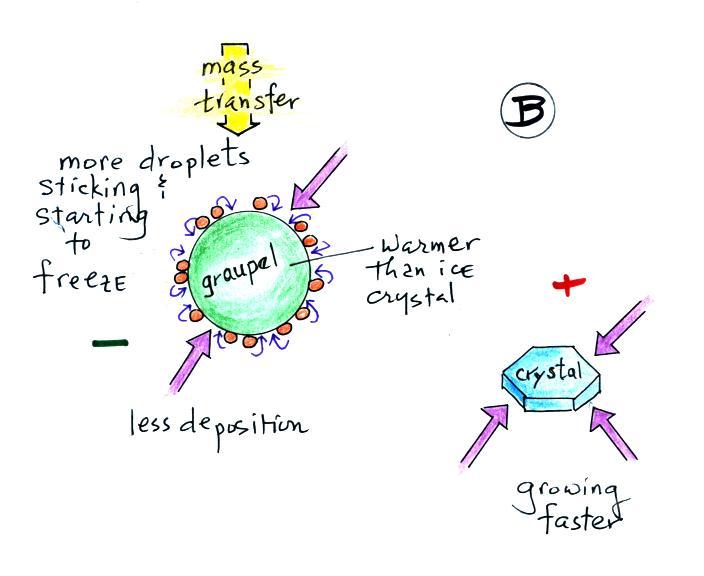
Region B
The effective liquid water content is higher and there are more
supercooled water droplets colliding with and sticking
to the graupel particle. Now as they release latent heat and try
to
freeze they are able to warm the graupel particle. The net rate
of deposition from the surroundings to the graupel particle is reduced
(2 arrows are shown in B
versus 3 arrows in A). Even with the deposition from the
droplets on the surface of the graupel particle, the ice crystal grows
more quickly and has the thicker quasi
liquid layer. Mass transfer during a collision goes to the
graupel particle and the graupel particle ends up with negative charge.
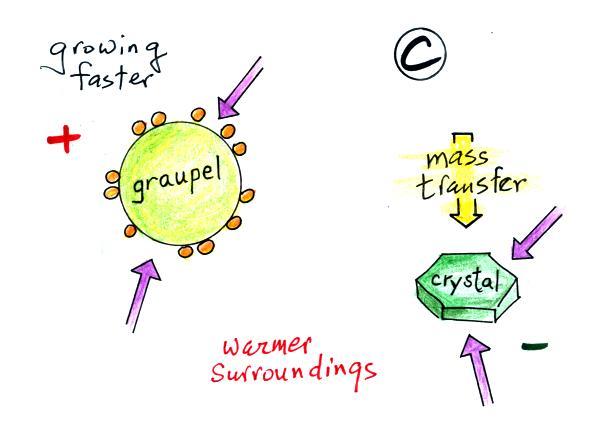
Both the ice crystal and the graupel particle are in warmer
surroundings and the rate of deposition to each is reduced. The
graupel is warmer than it was in Region B. Now however the
deposition from the accreted water droplets is increased because it
takes them longer to freeze. The graupel particle grows faster
and has the thicker quasi liquid layer. Mass transfer is to the
ice crystal again and it ends up with negative charge.
Next a couple of figures of the distribution of electrical charge in
clouds.
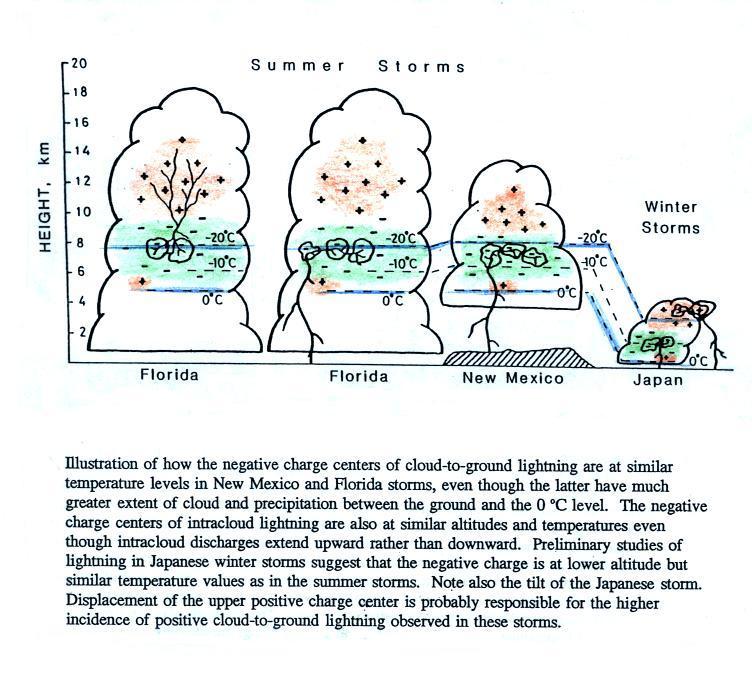
This is a fairly famous and widely
published figure (I added the colors). It shows the location of
negative charge that
is neutralized during cloud-to-ground and intracloud discharges in
clouds in Florida, New Mexico, and Japan. In each case the
negative charge is found in roughly the -10o C to -30o C temperature
range despite differences in cloud heights, cloud base altitudes, and
cloud thicknesses. (source: Krehbiel, Paul R., "The Electrical
Structure of Thunderstorms," Ch. 8 in The Earth's Electrical
Environment, National Academy Press, Washington, 1986)
The intent of this figure is to shown that the distribution of
charge in thunderstorms is often much more complex
than the simple tripolar model discussed above. (source: Stolzenburg,
M.,
W.D.
Rust,
and
T.C.
Marshall,
"Electrical
Structure in Thunderstorm
Convective Regions 3. Synthesis," J. Geophys. Res., 103, 14097-14108,
1998)
Most thunderstorms have the dipolar (or tripolar)
charge distribution as shown below at left. The majority of cloud
to ground (CG) discharges from these types of storms carry negative
charge to ground. Just a few percent of the CG discharges are
positively charged (we'll see though that these positive CG discharges
sometimes have very large peak currents).
A much larger percentage (50% or more) of positive CG discharges have
been observed coming from some Central Plains storms in recent field
experiments. This would suggest the clouds might have had an
inverted charge distribution like that shown below at right. And
one might wonder whether a different cloud electrification mechanism is
at work (different from the Reynolds, Brook, Gourley process discussed
last Thursday).
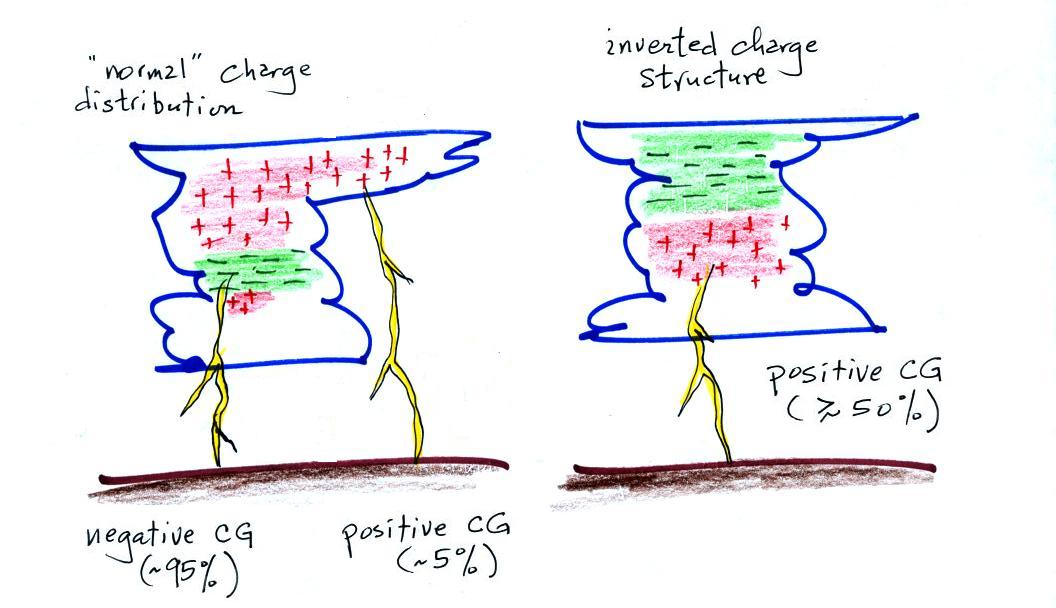
As you move upward from the bottom toward the top of the cloud you
encounter a positively charged screening layer, the main negative and
positive charge centers, and a positive screening layer at the top of
the cloud.
Just the opposite situation was observed in the inverted polarity
clouds. At first glance these clouds would seem to invalidate the
Reynolds, Brook, Gourley process we have been studying or at least
suggest there might be another process that sometimes is at work.
Follow up studies, however, seem to indicate that the non-inductive
electrication mechanism is capable of explaining clouds with
inverted charge
distributions. This is shown on the figure below
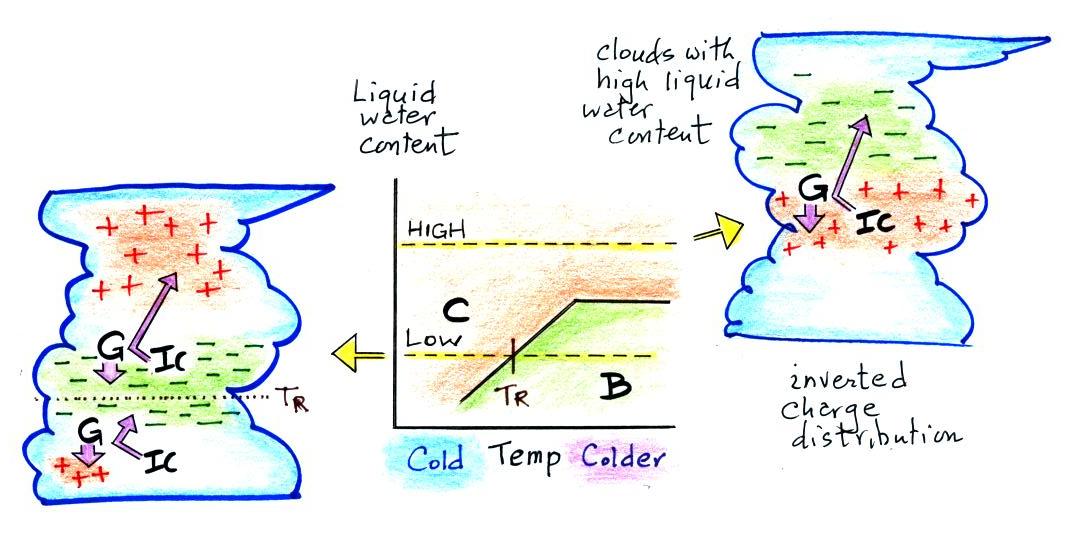
In the center of the figure is the
graph that we examined in some detail earlier in this lecture. It
shows the
polarity of charge acquired by a graupel particle colliding with ice
crystals in a laboratory simulation of a cloud environment containing
supercooled water
droplets. The liquid water content on the vertical axis is a
measure of the supercooled droplet concentration.
Liquid water content in a typical cloud would be found near the level
of the lower dotted line on the graph. The tripolar cloud charge
distribution in a typical cloud is shown at left. High in the
cloud where the temperature is cold, the graupel particle acquires
negative charge and the ice crystals positive charge (region B on the
graph). The ice
crystals are carried upward and form the main positive charge
center. The heavier graupel particle descends to form the main
negative charge center. Somewhat lower in the cloud where
temperatures are warmer than TR
(the reversal temperature) but still
below freezing the polarity of the charging changes (region C on the
graph). The graupel ends up with positive charge and the ice
crystals with negative charge. The positively charged graupel
form the lower positive charge centers.
It seems that the unusual Central Plains storms have very high liquid
water contents. If we look at the level of the upper dotted line
on the charging graph in the center of the figure we see that the
graupel particle always ends up with positive charge in this high LWC
environment. There is no charge reversal temperature. The
Reynolds, Brook, Gourley mechanism can account for clouds with inverted
charge distributions.




